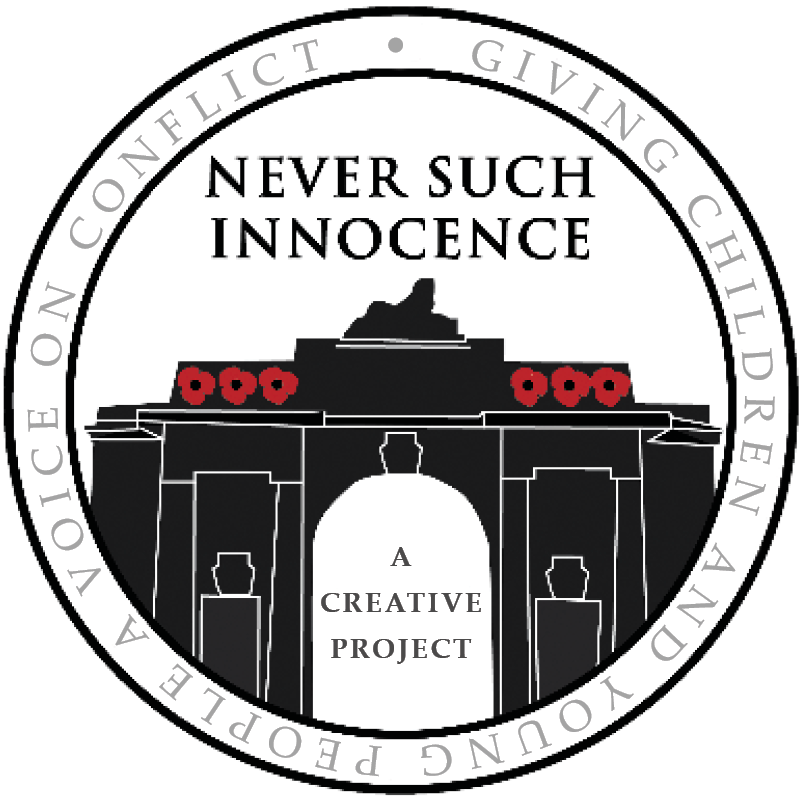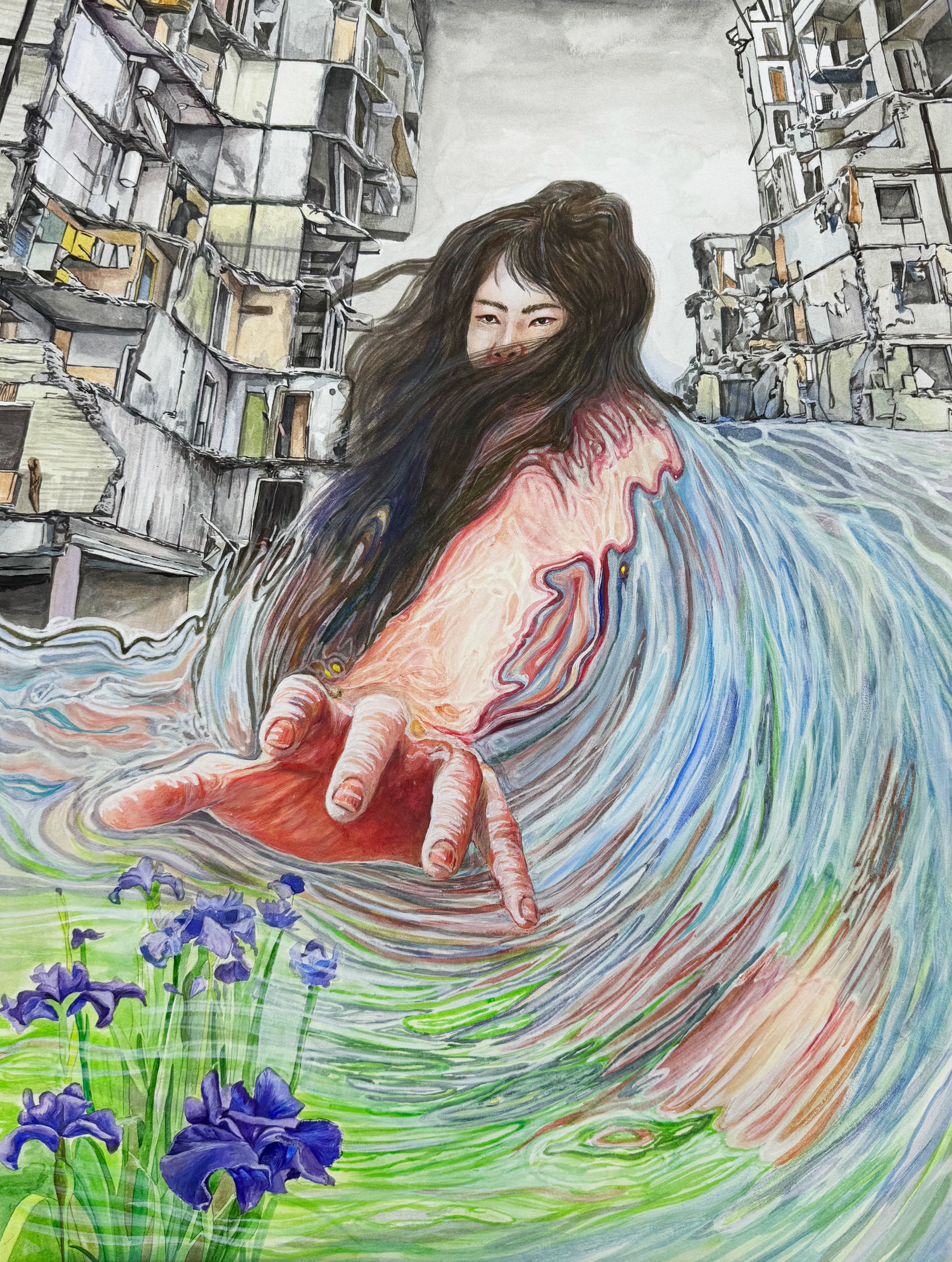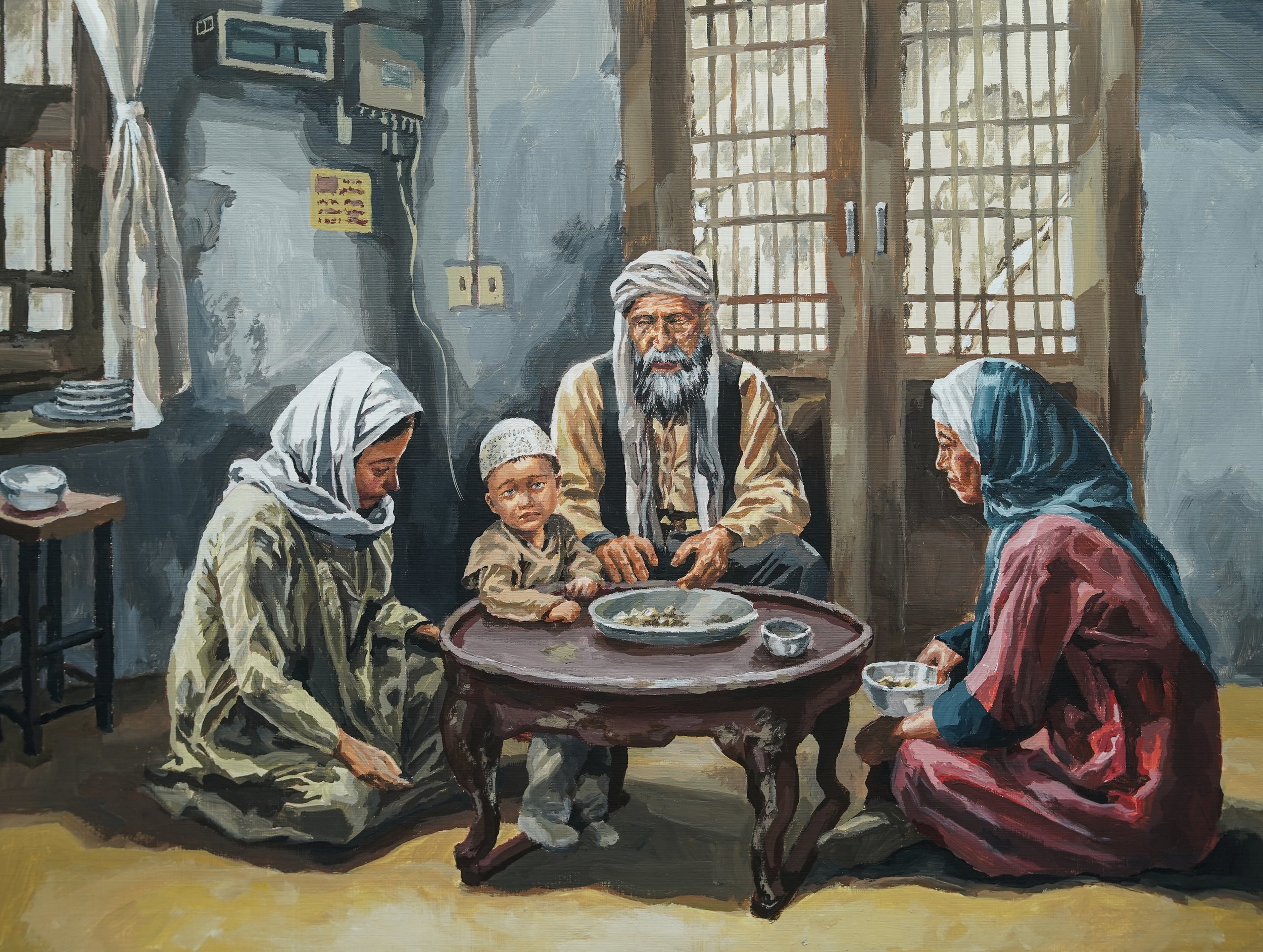Breaking the Cycle: Winter, Community and Family
/Winter is a season full of contrasts. Whilst it is a time when people come together to stay warm, celebrate and connect; these cold quiet days can feel quite lonely. This mix of isolation and togetherness can remind us of war and peace—while war separates people, moments of peace show how we can unite. One powerful example is the Christmas Truce of 1914, when soldiers on opposite sides of a war stopped fighting to sing songs, play football and share gifts. This post will look at how winter, family, and community can help us break the cycle of war and conflict. By exploring art, history, and the small things people can do alongside the art in our competition archives, we’ll see how these ideas can shape your submission for the question “How Can We Prevent Future Wars?“.
Banksy, 2018. Season’s Greetings. [mural] Port talbot, Wales
The symbol of winter is that of resting and reflection, offering a chance to pause, rethink, and prepare for Spring. Its stillness encourages people to look inward and consider how harmful cycles, such as conflict and division, can be broken. In art and literature, winter often represents both challenge and hope.
For example, in Banksy’s Season’s Greetings, the snow appears pure and peaceful at first glance, but on closer inspection, it is revealed to be ash, hinting at conflict and destruction. This juxtaposition captures the duality of winter—a season that can hide or highlight the need for change and peace.
jeewon, 16-18, south korea, the reflection of hope amidst destruction [watercolour on paper], never such innocence archives, london, (photo © never such innocence)
Jeewon’s [16-18, South Korea] “The Reflection of Hope Amidst Destruction” depicts “a girl, among the ruins, reaching for a blue iris, a flower whose language symbolises hope and truth”.
The duality of the colour palette shifting from muted to colourful reflects the girl as still unchanged from the destruction behind her, the water surrounding her and the flowers acting as a protective blanket. This again highlights the duality of the concept of the environment as a force for destruction and hope.
Jeewon contradicts the difference between the natural and manmade environment though, just like two sides of a colour filter the grey building seems to be a criticism on the effect of human architecture (including conflict based materials) on the rest of the natural world.
*Duality refers to a thing have having two sides/meaning/interpretations. ‘The Reflection of Hope Amongst Destruction‘ has two distinct colour palettes that divides the work into almost two worlds that have conflicting meaning.
Family plays a powerful role during war, acting as both a source of strength and a reminder of what is at stake. In the chaos of conflict, families find ways to stay connected—through letters, photographs, and traditions—that bring comfort and humanise the experience of war. These small but meaningful acts, like a letter from a parent or a picture of home, can remind soldiers and civilians alike of the love and unity they are fighting to protect.
Norman Rockwell, Freedom from Want, 1943, oil on canvas, illustration for The Saturday Evening Post, March 6, 1943, collection of Norman Rockwell Museum
Artists like Norman Rockwell capture this sense of family as a symbol of hope and peace, as seen in “Freedom from Want”, which portrays a family gathered around a holiday table, embodying the ideals of togetherness and stability even in difficult times.
Painted in the middle of the Second World War, the tension comes from the insistence of the rest of the world to join the war. People were still reeling from the losses of the First World War, so the fear of joining another global conflict was justifiably felt.
The title came from a speech by Franklin D. Roosevelt in January 1941 and is part of a series of four paintings in which the President highlighted essential human rights that should be universally protected. It was in December 1941, nearly a full year later, the American military joined the allies on the front lines after Imperial Japan dropped a bomb on Pearl Harbor.
*The other paintings in the series were called the ‘“Freedom of Speech and Expression“, “Freedom of Worship“, “Freedom from Fear“. Check the further reading list below to see more information on this topic.
Sangeun, 16-18, singapore, come home for dinner (please) [digital drawing], never such innocence archives, london, (photo © never such innocence)
One could say the title/context is as significant as the technical work itself, which is why the next work we’ll be addressing from our archives is “Come Home for Dinner (Please)” by Sangeun [16-18, Singapore]. The left side of the composition is people heavy, the right side of the work dominated by food and a phone pinged with a notification stating “Breaking - 10 Dead in War” atop a background of a soldier in uniform. The child and woman praying on the left and the war warning relies on the title which infers that they have a family member in the military and are awaiting news of survival, perhaps a father or brother. The (Please) a clear disagreement with the concept of conflict. One doesn’t have to have a military family member to imagine the fear of one’s loved one dying alone in a violent place with no home comforts.
War often tears families apart, motivating many to work toward peace for the sake of future generations. Families play a key role in breaking the cycle of violence, especially during winter holidays, when traditions emphasise unity and goodwill. Some families participate in peace movements by sharing stories of reconciliation, creating art that promotes understanding, or volunteering in their communities. These efforts show how family bonds can inspire action, reminding us that even in the darkest times, hope for a better future begins at home.
Asides from families, communities have a unique ability to bring people together, especially during winter festivities, creating spaces where shared humanity can transcend divisions of war and politics. Traditions like public Christmas markets or collective winter festivals offer moments of joy, connection, and healing. For example, after times of war, communities often rebuild by reviving these traditions, using them as opportunities to strengthen bonds and renew a sense of unity. These events remind people that despite differences, they share common values of hope, generosity, and peace. However this is unable to be fostered in times of conflict.
Hyunseung, 16-18, south korea, Cultural burden [acrylic on canvas], never such innocence archives, london, (photo © never such innocence)
Cultural Burden by Hyunseung [16-18, South Korea] reflects on the changes that refugees have to get accustomed to. The family around the table sharing a simple meal , while looking upset, perhaps brings a sense of normalcy to their change of circumstances. This piece in particular reminds me of one of the artworks mentioned in Claire Bishop’s Social Turn essay: Picnic (2001) by Oda Projesi. The photos of the installation event provides a different context to Hyunseung’s work, as the photos show joy in participating in a group - sitting around a table eating food can powerfully comment on the role of communities in fostering unity and shared humanity. The act of sharing a meal is universally symbolic of connection, warmth, and hospitality. In this context, it represents how communities can create safe spaces where people, even those displaced by war, can find comfort and belonging. This setting emphasizes the importance of basic human needs and how meeting them can spark moments of empathy and solidarity. Such imagery invites viewers to reflect on how collective actions, like welcoming refugees or creating communal spaces, can break down barriers and rebuild trust in times of conflict. Ultimately, the painting serves as a reminder that even in the face of displacement and hardship, communities have the power to heal and unite through acts of care and togetherness.
Oda Projesi, Picnic, 2001. Installation event with community participation, organized by Erik Göngrich, Oda Courtyard, Istanbul, June 10, 2001. source: THE SOCIAL TURN: COLLABORATION AND ITS DISCONTENTS - By Claire Bishop
Art also plays a significant role in fostering community and promoting healing after conflict. Community-based artworks or murals, as explored in Claire Bishop’s analysis of the “social turn” in art, emphasise collective participation and shared narratives. These projects often emerge as powerful tools for reflection and dialogue, allowing people to process trauma and envision a more peaceful future.
Winter, with its themes of stillness and renewal, is a particularly meaningful time for such initiatives. Whether through public art projects, storytelling, or cultural festivals, communities use this season to come together, finding strength in unity and imagining a world beyond the cycles of war and conflict.
*Read the analysis linked at Artforum.com in the Further Reading section, there are also many other group projects mentioned. How can you reapply this concept to the art submission?
John dalbiac luard, c.1855, A Welcome Arrival. [painting] private collection, photo © kulsoma khatun
John Dalbiac Luard’s A Welcome Arrival (c. 1855) offers a poignant metaphor for taking a break from the relentless cycle of war. Depicting a moment of respite, a break in the fighting, as soldiers pose for Luard’s sketches, the painting captures the emotional weight of connection and communication in times of conflict. The soldiers’ expressions, focused on talk and time rather than conflict, emphasise how art serves as a lifeline to peace and normalcy amid chaos. The scattered elements of military life—muddy uniforms, weapons set aside—contrast sharply with the warmth of human interaction, symbolising a temporary pause from violence.
This act of posing for and witnessing artwork, regardless of military or not, can be seen as a bridge between the battlefield and the comforts of home, highlighting the power of communication to sustain hope and foster peace. It reminds viewers that even in the heart of conflict, moments of connection can break the cycle of aggression and provide a glimpse of humanity’s capacity for unity. By focusing on this quiet, personal moment rather than scenes of battle, Luard underscores the importance of reflection, connection, and the human need for peace, even in the midst of war. The artwork invites us to consider how such pauses can inspire larger efforts toward reconciliation and understanding.
Yuheng, 14-16, canada, christmas truce [pencil, charcoal and chalk on paper], never such innocence archives, london, (photo © never such innocence)
Historically, winter has often brought pauses in war, as the harsh conditions forced combatants to reflect and regroup. One of the most striking examples is the Christmas Truce of 1914 beautifully drawn by Yuheng [14-16, Canada], when soldiers on opposing sides of World War I ceased fighting to sing carols, share gifts, and play football. The drawing’s centrepiece, the handshake, is bordered by two groups of soldiers in the background waving at each other. This rare moment of humanity in the midst of conflict illustrates how winter’s stillness can inspire opportunities for ceasefires and dialogue, even in the darkest times. Winter reminds us that periods of hardship can also bring clarity and the chance to envision a more peaceful future.
How can you shape your work this winter for the competition question “How Do We Prevent Future Wars?” by reflecting themes explored in this blog post?
Winter, family, and community serve as powerful reminders of our shared humanity and the potential to break cycles of conflict through understanding and togetherness. In the stillness of winter, we find space to reflect and reconnect, strengthening the bonds that unite us. Moments of kindness and collaboration, whether within families or entire communities, highlight the ways we can build a foundation for lasting peace.
Just as winter eventually gives way to the renewal of spring, small efforts to nurture peace—through communication, shared traditions, or acts of compassion—can help move the world beyond cycles of war and division. This winter, let us take inspiration from history and art to foster hope and unity. Whether by creating meaningful artwork, joining community events, or simply sharing a moment of kindness with someone in need, we can all play a role in imagining and creating a better future without conflict.
Further Reading:
Context on the Banksy artwork: https://banksyexplained.com/seasons-greetings-december-2018/
The Imperial War Museum explains the Christmas Truce: https://www.iwm.org.uk/history/the-real-story-of-the-christmas-truce
The Norman Rockwell Online Collections and specific searches for “Family“ : https://collection.nrm.org/#view=list&id=b288&modules=ecatalogue&PriPrimaryMakerLocal=rockwell&TitMainTitle=family&MulHasMultiMedia=Y
Four Freedoms Speech at the Franklin D. Roosevelt Presidential Library and Museum website : https://www.fdrlibrary.org/four-freedoms
America joining the Second World War : https://www.nationalww2museum.org/war/articles/arsenal-ally-united-states-enters-war#:~:text=On%20December%207%2C%201941%2C%20Japanese,declared%20war%20on%20Imperial%20Japan.
Claire Bishop and the Art of the Social Turn : https://www.artforum.com/features/the-social-turn-collaboration-and-its-discontents-173361/
John Dalbiac Luard at the National Army Museum, London (The artwork is in their archive, you need to book to view) : https://collection.nam.ac.uk/detail.php?acc=1958-08-18-1














